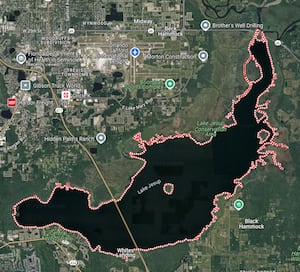Residents and visitors are advised to take the following precautions:
• Do not drink, swim, wade, use personal watercraft, or come into contact with waters where there is a visible bloom.
• Wash your skin and clothing with soap and water if you come into contact with algae, discolored water, or water that smells unpleasant.
• Keep pets and livestock away from the area to avoid contact with water. Waters where algae blooms are not safe for animals, so pets and livestock should use an alternative water source when algae blooms are present.
• Do not cook or clean dishes with water contaminated by algae blooms. Boiling the water will not eliminate toxins.
• Eating fillets from healthy fish caught in freshwater lakes experiencing blooms is safe. Rinse fish fillets with tap or bottled water, throw out the guts, and cook fish thoroughly.
• Do not eat shellfish in waters with algae blooms
What is Blue-Green Algae?
Blue-green algae are a type of bacteria that is common in Florida’s freshwater environments. A bloom occurs when the rapid growth of algae leads to an accumulation of individual cells that discolor water and often produce floating mats that emit unpleasant odors.
Blue-green algae blooms can also appear as scum, foam, or paint on the surface of the water in various colors. To learn more about the appearance of algae blooms, visit Protecting Florida Together.
Is Blue-Green Algae Harmful?
Blue-green algae can produce toxins that are harmful to humans, pets and ecosystems, including fish and other aquatic animals.
Sensitive individuals (e.g., children, the elderly, and the immunocompromised) may still be at risk even at low concentrations and should avoid any exposure.
If you have other health questions or concerns about blue-green algae, please call DOH-Seminole at 407-665-3604.
——————————————————————–
El Departamento de Salud de Florida en el condado de Orange (DOH-Seminole) advierte al público sobre la presencia de algas verdeazuladas en el Lago Marian cerca del área del pabellón. Se están realizando pruebas de muestras de agua. Las algas verdeazuladas tienen el potencial de producir toxinas. Dado que las condiciones ambientales pueden cambiar en cualquier momento, es importante tener precaución, incluso si aún no se ha confirmado la presencia de toxinas.
Se recomienda a los residentes y visitantes que tomen las siguientes precauciones:
¿Qué son las algas verde azules?
Las algas verde azules son un tipo de bacteria común en los ambientes de agua dulce de Florida. Una floración ocurre cuando el rápido crecimiento de algas conduce a una acumulación de células individuales que decoloran el agua y, a menudo, producen esteras flotantes que emiten olores desagradables.
Las floraciones de algas verde azules también pueden aparecer como espuma, o pintura en la superficie del agua en varios colores. Para obtener más información sobre la aparición de la proliferación de algas, visite Protecting Florida Together.
¿Son dañinas las algas verde azules?
Las algas verde azules pueden producir toxinas que pueden ser perjudiciales para los seres humanos y las mascotas, así como para los ecosistemas, incluidos los peces y otros animales acuáticos.
Las personas sensibles (p. ej., niños, ancianos y personas inmunocomprometidas) aún pueden estar en riesgo incluso en concentraciones bajas y deben evitar cualquier exposición.
Si tiene otras preguntas de salud o inquietudes sobre las algas verde azules, llame a DOH-Seminole al 407-665-3604.
Click here to download our free news, weather and smart TV apps. And click here to stream Channel 9 Eyewitness News live.
Read the full article here


